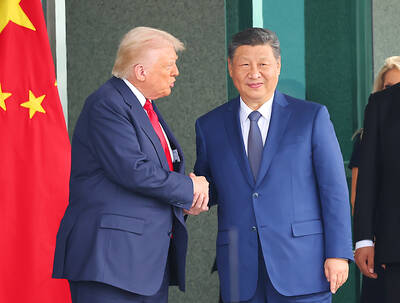Renewable energy suppliers will soon be able to apply for distribution permits to speed up the development of nation’s renewable energy industry, the Ministry of Economic Affairs said yesterday.
“Power distributors will be able to start applying for permits to transmit and distribute power from renewable energy suppliers to customers at the end of next month at the earliest,” Bureau of Energy official Lee Chih-yuan (李志遠) told reporters at the ministry.
Renewable energy suppliers can finally start selling electricity to customers, Lee added.
The legislature in January passed the amended Electricity Act (電業法), which allows renewable energy suppliers to sell electricity to enterprises and households, instead of only selling power to Taiwan Power Co (Taipower, 台電).
Under the amended regulations, distributors would pay less when using Taipower’s grid if they are transmitting renewable energy.
The ministry yesterday approved the discount ranges, Lee said.
For instance, the fee for transmitting solar power on Taipower’s grid is to be NT$0.0108 to NT$0.0169 per kilowatt-hour (kWh), compared with NT$0.2861 to NT$0.4462 per kWh for coal-fired electricity, Lee said.
Renewable energy suppliers can also choose to build their own direct lines, for which they are only required to pay power dispatching and assisted service fees to Taipower, Lee said.
Lee said the ministry would review and adjust the pricing mechanism for renewable and non-renewable energy sources on an annual basis.

RUN IT BACK: A succesful first project working with hyperscalers to design chips encouraged MediaTek to start a second project, aiming to hit stride in 2028 MediaTek Inc (聯發科), the world’s biggest smartphone chip supplier, yesterday said it is engaging a second hyperscaler to help design artificial intelligence (AI) accelerators used in data centers following a similar project expected to generate revenue streams soon. The first AI accelerator project is to bring in US$1 billion revenue next year and several billion US dollars more in 2027, MediaTek chief executive officer Rick Tsai (蔡力行) told a virtual investor conference yesterday. The second AI accelerator project is expected to contribute to revenue beginning in 2028, Tsai said. MediaTek yesterday raised its revenue forecast for the global AI accelerator used

TEMPORARY TRUCE: China has made concessions to ease rare earth trade controls, among others, while Washington holds fire on a 100% tariff on all Chinese goods China is effectively suspending implementation of additional export controls on rare earth metals and terminating investigations targeting US companies in the semiconductor supply chain, the White House announced. The White House on Saturday issued a fact sheet outlining some details of the trade pact agreed to earlier in the week by US President Donald Trump and Chinese President Xi Jinping (習近平) that aimed to ease tensions between the world’s two largest economies. Under the deal, China is to issue general licenses valid for exports of rare earths, gallium, germanium, antimony and graphite “for the benefit of US end users and their suppliers

Dutch chipmaker Nexperia BV’s China unit yesterday said that it had established sufficient inventories of finished goods and works-in-progress, and that its supply chain remained secure and stable after its parent halted wafer supplies. The Dutch company suspended supplies of wafers to its Chinese assembly plant a week ago, calling it “a direct consequence of the local management’s recent failure to comply with the agreed contractual payment terms,” Reuters reported on Friday last week. Its China unit called Nexperia’s suspension “unilateral” and “extremely irresponsible,” adding that the Dutch parent’s claim about contractual payment was “misleading and highly deceptive,” according to a statement

Artificial intelligence (AI) giant Nvidia Corp’s most advanced chips would be reserved for US companies and kept out of China and other countries, US President Donald Trump said. During an interview that aired on Sunday on CBS’ 60 Minutes program and in comments to reporters aboard Air Force One, Trump said only US customers should have access to the top-end Blackwell chips offered by Nvidia, the world’s most valuable company by market capitalization. “The most advanced, we will not let anybody have them other than the United States,” he told CBS, echoing remarks made earlier to reporters as he returned to Washington